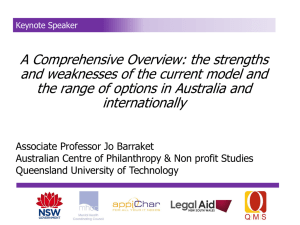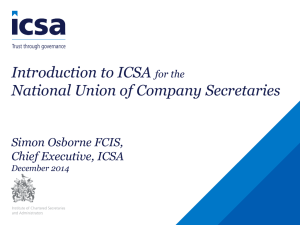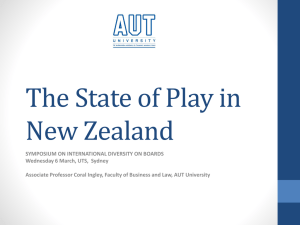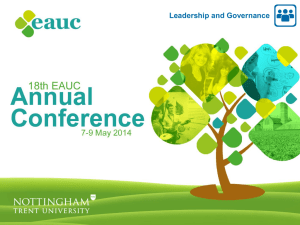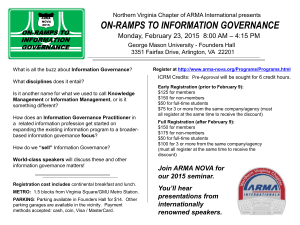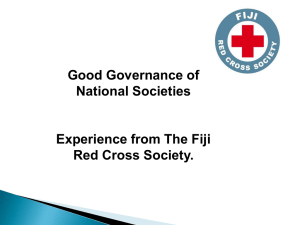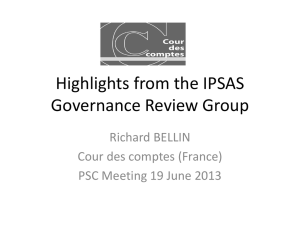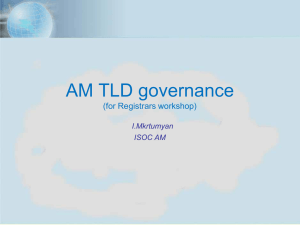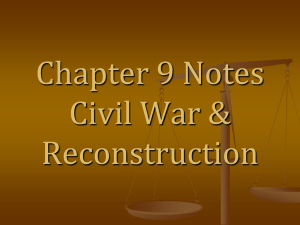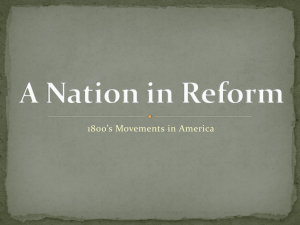PowerPoint - The BC Assembly of First Nations
advertisement
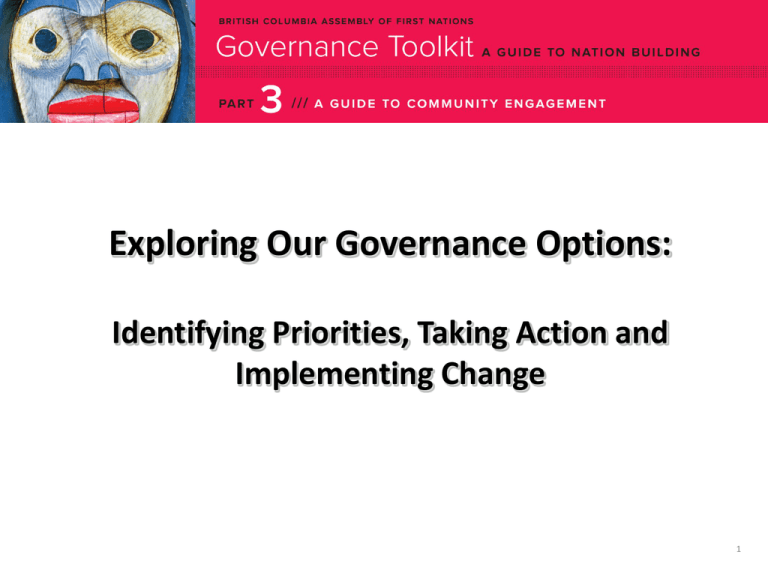
Exploring Our Governance Options: Identifying Priorities, Taking Action and Implementing Change 1 The need for strong & appropriate governance • “Governance” means establishing rules to coordinate our actions and achieve our goals • The institutions we create to make rules and then enforce them, we call “government” • “Governance” and “government” come in many forms but are always needed • The quality of governance, much more than its specific form, has a huge impact on the fortunes of any given society—ours are no exception • Societies that govern well simply do better economically, socially and politically than those that do not • Effective governance increases a society’s chances of meeting the needs of its people 2 Rebuilding First Nations’ governance • Our Nations were historically self-governing • Since colonization systems of governance have been imposed on our Nations – First Nation peoples, lands and economies have been governed separate and apart from non-Aboriginal Canada under federal administrative authority in accordance with the Indian Act • The impoverished notion of governance under the Indian Act is neither an appropriate governance framework for our people – nor for any people – The status quo is having a negative impact on our societies’ ability to meet the needs of our people • In Canada and particularly in BC, work is underway to rebuild our Nations – Our Nations are implementing our inherent right of self-government and are moving away from governance under the Indian Act and control by Canada – It Is not small task to decolonize 3 Developing a “critical path” to move beyond the Indian Act • In BC, approximately 70% of our Nations have undergone, or are undergoing, governance reform • The process of reform starts at the community level – Based on each Nation’s vision, leadership and culture – Governance must be developed from the ground up based on the needs of our community • After considering the needs in our community and what governance reform may be desired, we need to consider our options for governance reform – The options can be viewed along a “continuum of governance” options that incrementally could lead to full self-government • Considering the options and developing our own governance “critical path” is required to move beyond the Indian Act – will be done on our own time and based on our own governance priorities 4 Exploring the options • To help First Nations consider our governance options and to identify where more political work is needed to create options, the BCAFN has produced The Governance Report, “Part 1 of the Governance Toolkit: A Guide to Nation Building” (Available for download on our site, at www.bcafn.ca) • The Governance Report brings together in one place the governance work and experiences of First Nations in BC and sets out the current options along the “governance continuum” • The Report will assist our Nations in developing our own critical path to implement governance reform and re-establish strong and appropriate governance for our citizens and lands, both our existing lands (i.e., reserves) and our traditional territory • The following slides set out the structure of The Governance Report 5 Part 1 – The Governance Report Key Assumptions There are some key assumptions behind the Report—These are: • Our Nations have an “inherent right of self-government” – Section 35 of the Constitution Act, 1982 – United Nations Declaration on the Rights of Indigenous Peoples • The primary building block of governance for our peoples is the “Nation” • Primary relationship between our Nations and Crown is with the federal government 6 Part 1 – The Governance Report Cont’d… The Report is divided into four sections: • Section One – Options for Governance Reform History of evolving First Nations’ governance & the development of options along a governance continuum ranging from under the Indian Act, to sectoral and comprehensive governance arrangements • Section Two - Core Institutions of Governance Focusses on the structure of First Nations’ governance and its core institutions; the Citizens, the governing body, and the constitution • Section Three - Powers (Jurisdictions) of the First Nation Explores 33 powers (jurisdictions) and provides background information on the subject area and looks at what our Nations are doing in each area along the governance continuum using comparative charts along with resource guides • Section Four - Financing First Nations’ Governance Considers the costs of our Nations’ governance, sources of First Nations’ revenues, public debt financing, transfers from other governments, and the evolving fiscal relationship with Canada including the impact of “own source revenue” on federal transfers 7 BRITISH COLUMBIA ASSEMBLY OF FIRST NATIONS /// WWW.BCAFN.CA JUNE 2012 8 Part 1 - Section 1 Options for Governance Reform • Section 1 provides a brief history of evolving First Nations’ governance within Canada • It considers the options along the governance continuum: – Indian Act Governance – Sectoral Governance Initiatives – Comprehensive Governance Arrangements 9 Strategic use of the Indian Act Interim Steps to Comprehensive Governance Arrangements • Developing a membership code – Custom (Section 10) • Developing your own election rules (section 74(1)/Custom) • Assumption of delegated land management powers (section 53 & 60) • Use of by-law making powers (Section 81) • Implementing property taxation (Section 83) 10 Sectoral Governance Arrangements • There are still a limited number of forums for negotiating comprehensive self-government agreements with Canada and, in some cases, provinces • First Nations have led initiatives to advance governance in specific areas such as lands, education, health, oil and gas and fiscal relations • These initiatives do not require negotiating all aspects of self-government • Some sectoral initiatives are national in scope and some are restricted to British Columbia • Processes and jurisdiction under sectoral initiatives are found in federal and/or provincial legislation dealing with the subject area • Any terms and conditions for participating in a sectoral governance initiative are set out in the Report 11 Examples of Sectoral Governance Initiatives • On-reserve: • Framework Agreement on First Nation Land Management and the First Nations Land Management Act • First Nations Oil and Gas and Moneys Management Act • First Nations Fiscal and Statistical Management Act • BC Education Jurisdiction Framework Agreement • Off-reserve: • Resource based “shared decision-making”, “reconciliation”, and “strategic engagement” agreements with the province 12 Comprehensive Governance Arrangements • Some First Nations are no longer governing under the Indian Act at all and have comprehensive governance arrangements with Canada, and in most cases with BC • These First Nations are self-governing within the terms of their arrangements • For example: As part of modern claims settlements (e.g. Nisga’a, Tsawwassen, and Maa-nulth) • For example: Stand alone self-government arrangements. (e.g. Sechelt and Westbank) 13 Where is our Nation along the continuum of governance reform? BRITISH COLUMBIA ASSEMBLY OF FIRST NATIONS /// WWW.BCAFN.CA JUNE 2012 14 Part 1 - Section 2 Core Institutions of Governance Section 2 of the Report looks at the core institutions of government. Core institutions are those practices, bodies and structures that together constitute government • Legal Status and Capacity – All governments require basic legal recognition to carry out their duties • The Citizens – Who is entitled to be a “citizen” of a Nation? • The Governing body – The core institution of any government is its governing body (e.g., chief and council) • The Constitution – The fundamental law of any Nation 15 Part 1 - Section 3 Powers (Jurisdictions) of the First Nation What powers (jurisdictions) is your Nation considering exercising when looking at its needs today and into the future (e.g., land management, health, education, child and family etc.)? 16 Part 1 - Section 3 Powers (Jurisdictions) of the First Nation • Structure of Part 1: Section 3—Section 3 of the Governance Report looks at 33 different powers (jurisdictions), arranged alphabetically and considered along the “governance continuum” • Each Chapter is arranged as follows: • • • • • • • Background Indian Act Governance Sectoral Governance Initiatives Comprehensive Governance Arrangements (Sechelt, Westbank, Nisga’a, Tsawwassen and Maa-nulth) • Comparative Chart BC First Nations’ Laws/By-laws in Force and Other Activities Resources The following slides provide chapter summaries for Education, Financial Administration, Health and Land Management 17 Part 1 - Section 3.7 Education Background • Identified as the national priority of AFN • First Nations’ jurisdiction over First Nations education on reserve in BC • Over 129 First Nations-controlled schools in BC Indian Act Governance • No jurisdiction only administrative arrangements Sectoral Governance Initiatives • 63 First Nations have indicated intent to negotiate jurisdiction agreements under the BC First Education initiative. Comprehensive Governance Arrangements • First Nations have jurisdiction over K-12 education Resources • First Nations Education Steering Committee (FNESC) • First Nations Education Authority • BC First Nations Schools Association (FNSA) 18 Part 1 - Section 3.11 Financial Administration Background • Importance of sound financial management rules • Significant developments in First Nations’ financial management practices and standards Indian Act Governance • 14 First Nations have Indian Act by-laws Sectoral Governance Initiatives • First Nations Fiscal and Statistical Management Act and the establishment of the FN Financial Management Board • First Nations Oil and Gas and Moneys Management Act • Framework Agreement on First Nation Land Management and First Nations Land Management Act Comprehensive Governance Arrangements • All First Nations have jurisdiction over internal financial management. Resources • First Nations Financial Management Board • Aboriginal Financial Officers Association • First Nation Finance Authority • First Nations Tax Commission 19 Part 1 - Section 3.15 Health Background • Depending on context, federal, provincial or First Nation authority applies • Collectively, providing health services is now the single largest budgetary expenditure for all governments Indian Act Governance • Section 73, 81(1) A number of First Nations have enacted health related bylaws but none displace federal or provincial authority Sectoral Governance Initiatives • Transformative Change Accord: First Nations Health Plan • BC Tripartite Framework Agreement on First Nation Health Governance • Moving to establish a BC First Nations Health Authority Comprehensive Governance Arrangements • While some self-government agreements include provisions for jurisdiction over health services, no First Nations currently exercise broad jurisdictional powers over these services. Resources • First Nations Health Council • First Nations and Inuit Health Branch – Pacific Region 20 Part 1 - Section 3.19 Land Management Background • Land is fundamental to First Nations. Title to First Nation lands is held in different ways. Reserves are held and governed federally under section 91(24) of the Constitution Act 1867. 32 sections (approximately 25%) of the Indian Act deals with lands and land management Indian Act Governance • Delegated Authority under sections 53 & 60 Sectoral Governance Initiatives • Framework Agreement on First Nation Land Management Act (FNLMA) and First Nations Land Management Act • First Nations Commercial and Industrial Development Act (FNCIDA) Comprehensive Governance Arrangements • All provide jurisdiction over lands and land management including establishing the rules for the creation and registration of interests in lands. Resources • Lands Advisory Board (LAB) • National Aboriginal Land Managers Association (NALMA) • First Nations Alliance 4 Land Management (FNA4LM) 21 Part 1 - Section 4 Financing First Nations’ Governance Section 4 of The Governance Report looks at how the cost of running our governments and providing programs and services will be met and our evolving fiscal relationship with Canada. The section is organized as follows: 4.1 Costing our Nations’ governance 4.2 First Nations Revenues • First Nations’ Own Source Revenues – – – – – – – – Fees and Charges for Services Taxes for the provision of Local Services Consumption Taxes Income Tax Royalties/Resource Rents Land Leasing Revenues off First Nation Lands Business Revenues • Public Debt Financing • Transfers from other Governments – – Indian Act Sectoral and Comprehensive Governance Arrangements 4.3 Principles of the Fiscal Financing Relationship 4.4 Own Source Revenue Impact on Federal Transfers 22 Next Steps: matching governance options with our needs • Based on our community’s identified needs and having considered our current options for governance reform, our community may be decide to pursue governance reform in a particular area • Some of the options for governance reform will require negotiations with Canada and in some cases BC • Where negotiations are required we will need to organize and get ready for these negotiations • Any options we choose will require a lot of hard work and need community involvement 23 Next Steps: lobbying and advocacy • In some cases the post-colonial door to governance reform is still being kept closed (e.g., due to current legal limitations for governance reform as well as federally-imposed limitations and political unwillingness) • To open up the door fully we will need to work with other First Nations. Collectively we are stronger. • In some cases we may choose to simply embark on governance reform with or without support from Canada and/or BC; the “just do it” approach – although there are limitations and risks to doing that we need to appreciate. 24 BRITISH COLUMBIA ASSEMBLY OF FIRST NATIONS /// WWW.BCAFN.CA JUNE 2012 25 Ratification of Governance Reforms • Where our community decides to undertake governance reform it is likely there will be a requirement for a community vote to “ratify” the governance proposal. • Some issues we will need to consider when ratifying governance proposals include: • Information to be provided to our citizens and how it is provided • Role of the governing body (e.g., chief and council) and “community champions” • Ratification thresholds (e.g., absolute majority, double majority or simple majority) 26 Implementation and beyond Implementation • If our Nation has gone through a process of successful governance reform, a whole new chapter begins in respect of those reforms • Rights are given a voice in practice and it is becomes our collective job to implement those reforms • The promise of self-government and the right of self-determination become the responsibility of the community Monitoring progress, ongoing evaluation and future initiatives • Governance is ongoing –growing, changing and adapting to the climate • Whatever governance reform initiatives we undertake, we will need to continually evaluate their effectiveness • If we are successful in our governance reform initiatives this could lead to further reforms—Success begets success 27

